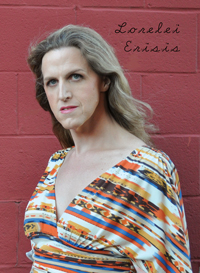By: Lorelei Erisis*/TRT Columnist—
Merely hours ago, I returned home from spending the past two days at the True Colors Conference in Connecticut. I was there to represent one of the several organizations with which I work: in this case, the Transcending Boundaries Conference, which will be happening in just a few weeks.
Given the wide variety of attendees at True Colors and the overall focus on youth, I had rather expected to write about some new, particularly cutting edge gender thing, or a fresh take on sexuality and identity. Instead, I find myself, quite unexpectedly inspired to write a few positive words about an oft-maligned and controversial segment of the transgender umbrella: crossdressers. I’m not really sure it’s going to win me a lot of friends, but I honestly believe that a little defense of crossdressers is in order. [pullquote] Instead, I find myself, quite unexpectedly inspired to write a few positive words about an oft-maligned and controversial segment of the transgender umbrella: crossdressers.[/pullquote]
If you are a regular reader of this column, you will know that I tend to see the world as a complicated place. I firmly believe we live in a world less as black and white, but rather filled out by gradations of gray. In the world of gender identity and gender presentation crossdressers definitely represent a big old gray area, a wild and wooly frontier of gender.
An admission: crossdressers make me wildly uncomfortable, a feeling I know I share with a good number of other folks. Speaking as a politician and activist, the inclusion of crossdressers under a trans umbrella can be politically inconvenient. They are the fly in the ointment when it comes to arguments for public accommodations.
More than that though, crossdressers often remind transsexuals and other transitioning folks of awkward, confused and painful times in our own transitions. Many of us, particularly those who have transitioned later in life, will have gone through a stage where we did not pass as well as we would have liked to, when perhaps we were not yet comfortable in our own skins, trying to figure out how to dress, move, talk, and be accepted as a woman, playing catch-up on years of missed female socializations. When our opponents talk about men in the women’s room, it is often a picture of a badly dressed crossdresser, or at least the idea of one, that they will put forth, and it definitely is a thorny question. What is the priority when it comes to public accommodations: gender identity or gender presentation? Both? [pullquote]When our opponents talk about men in the women’s room, it is often a picture of a badly dressed crossdresser, or at least the idea of one, that they will put forth, and it definitely is a thorny question. What is the priority when it comes to public accommodations: gender identity or gender presentation? Both?[/pullquote]
Frankly, I’m speaking pretty specifically here of male-bodied, male-identified people who choose to present for varying and most often temporary periods of time as female. People who, while their gender presentation might be female, their gender identity remains, at least to some large degree, as male. The reasons they may do this are a great deal more varied than the general public tends to realize. While it is absolutely true that some wear women’s clothing for erotic stimulation or sexual satisfaction, there are a great many more, in my own experience, who present as female in order to express some part of themselves that they may not have the outlet for in other parts of their lives. It can be a way to connect with a softer or more feminine side that is often inaccessible to those who dwell within a still very often hyper-masculinized world. They may live in a world where men are supposed to be tough, strong, dirty, sports-loving and beer-guzzling, a world where they must never, never cry or show tender emotions and which quite frowns upon frilly, pretty things. Cross-dressing for these folks is a way to play with these forbidden expressions of femininity, to explore their own gender and self-identities.
That is the central thesis of this roundabout argument—that exploration of self—because these lines are very rarely as clear as we’d like. This is the gray.
Many of us share these narratives where we tell the world how we’ve always known our gender, how we knew when we were kids that we were women. Yet, though in many senses that is often true, for many of us it takes a long time and a lot of work to realize the truth of this. It may then take a good deal longer to accept ourselves for who we are. We may flirt with our identity for years, convince ourselves we simply like to play dress up occasionally. While that may remain true for some percentage of folks who identify as crossdressers—which is a perfectly fine and healthy thing—for many of us, it is a stage we go through on our way to acceptance. It is often a very necessary launching point for our journeys of transition.
So, what I ask is this: the next time you find yourself speaking out against our crossdressed cousins, take a moment to consider what it is that truly bothers you, why you feel the need to separate your particular segment of the umbrella away. Try looking inward. There are few things that are capable of making us more uncomfortable than our own reflections, but any one of those folks who identify as a crossdresser today might come out as one of our trans sisters tomorrow.
Slainte!
*Lorelei Erisis is an activist, adventurer and pageant queen. Send your questions about trans issues, gender and sexuality to her at loreleiersis@gmail.com.








